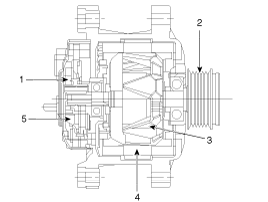
The charging system includes a battery, an alternator with a built-in regulator, and the charging indicator light and wire.
The Alternator has built-in diodes, each rectifying AC current to DC current.
DC current appears at alternator "B" terminal.
The charging voltage of this alternator is regulated by the ECM.
The main components of the alternator are the rotor, stator, rectifier, capacitor brushes, bearings and V-ribbed belt pulley. The brush holder contains a built-in electronic voltage regulator.

1. Brush 2. Belt pulley 3. Rotor | 4. Stator 5. Rectifier |
Alternator management system controls the charging voltage set point in order to improve fuel economy, manage alternator load under various operating conditions, keep the battery charged, and protect the battery from over-charging. Battery sensor is mounted on battery (-) terminal. It transmits battery voltage, current, temperature information to ECM. ECM controls generating voltage by duty cycle based on the signals from battery sensor and vehicle operating conditions.
The system conducts discharging control when accelerating a vehicle. Vehicle reduces an alternator loadand consumes an electric power form a battery. The system conducts charging control when decelerating a vehicle. Vehicle increases an alternator load and charges a battery.